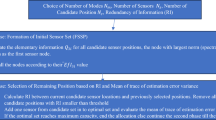Abstract
Structural health monitoring (SHM) provides an effective approach to ensure the safety of structures. However, with the restriction of the cost of sensor system and data processing, only a small number of sensors could be available in the health monitoring system (HMS). In order to obtain the best identification of structural characteristics, optimal sensor placement (OSP) becomes an inevitable task in the design of HMS. This paper introduces the process for determining the OSP in HMS of a suspension bridge, in which four different OSP methods have been investigated, including the effective independence (EI) method, the effective independence driving-point residue (EFI-DPR) method, the minimized modal assurance criterion (minMAC) method and the principal subset selection-based extended EI (PSS-EI) method. Then, three criteria, which are modal assurance matrix (MAC), condition number (CN) of mode shape matrix and determinant of Fisher information matrix (FIM), were employed to evaluate the effect of the OSP methods respectively. The result showed that the PSS-EI method developed has the ability to guarantee the highest determinant of FIM, a relatively small off-diagonal term of MAC and agreeable CN, as well as the deployment of sensors in a uniform and symmetric fashion for the studied bridge. Finally, the scheme obtained by PSS-EI was adopted in the HMS.
Similar content being viewed by others
References
Feng M R. Bridges for the Benefit of the People-development of Bridges in China (in Chinese). Technical Report, 2009
Ou J P, Li H. Structural health monitoring in mainland China: Review and future trends. Struct Health Moint, 2010, 9(3): 219–232
Li D S, Hu Q, Ou J P, et al. Fatigue damage characterization of carbon fiber reinforced polymer bridge cables: Wavelet transform analysis for clustering acoustic emission data. Sci China Tech Sci, 2011, 54: 379–387
Deng Y, Ding Y L, Li A Q, et al. Fatigue reliability assessment for bridge welded details using long-term monitoring data. Sci China Tech Sci, 2011, 54: 3371–3381
Meo M, Zumpano G. On the optimal sensor placement techniques for a bridge structure. Eng Struct, 2005, 27(10): 1488–1497
Heo G, Wang M L, Satpathi D. Optimal transducer placement for health monitoring of long span bridge. Soil Dyn Earthq Eng, 1997, 16(7–8): 495–502
Guo H Y, Zhang L, Zhang L, et al. Optimal placement of sensors for structural health monitoring using improved genetic algorithms. Smart Mater Struct, 2004, 13(3): 528–534
Flynn E B, Todd M D. A Bayesian approach to optimal sensor placement for structural health monitoring with application to active sensing. Mech Syst Signal Pr, 2010, 24(4): 891–903
Worden K, Burrows A P. Optimal sensor placement for fault detection. Eng Struct, 2001, 23(8): 885–901
Li D S, Zhang Y, Ren L, et al. Sensor deployment for structural health monitoring and their evaluation (in Chinese). Adv Mech, 2011, 41(1): 39–50
Chopra A K. Dynamics of Structures: Theory and Application to Earthquake Engineering. 3rd ed. New Jersey: Pearson Education, Inc, 1993. 422–426
Kammer D C. Sensor placement for on-orbit modal identification and correlation of large space structures. J Guid Control Dynam, 1991, 14(2): 251–259
Kammer D C. Effects of model error on sensor placement for on-orbit modal identification of large space structures. J Guid Control Dynam, 1992, 15(2): 334–341
Kammer D C. Effects of noise on sensor placement for on-orbit modal identification of large space structures. J Dyn Syst-T ASME, 1992, 114(3): 436–443
Li D S, Li H N, Fritzen C P. A note on fast computation of effective independence through QR downdating for sensor placement. Mech Syst Signal Pr, 2009, 23(4): 1160–1168
Papoulis A. Probability, Random Variables, and Stochastic Process. 3rd ed. New York: McGraw Hill, 1991. 263–265
Papadopoulos M, Garcia E. Sensor placement methodologies for dynamic testing. AIAA J, 1998, 36(2): 256–263
Carne T G, Dohrmann C R. A modal test design strategy for model correlation. SAND-94-2702C, 1995
Golub G H, Van Loan C F. Matrix Computation. 3rd ed. Baltimore and London: John Hopkins, 1996. 590–595
Fei Q, Li A, Miao C, et al. Vibration sensor placement method based on principal subset selection (in Chinese). Chinese J Theoretical Appl Mech, 2008, 40(4): 543–549
Author information
Authors and Affiliations
Corresponding author
Rights and permissions
About this article
Cite this article
Li, B., Li, D., Zhao, X. et al. Optimal sensor placement in health monitoring of suspension bridge. Sci. China Technol. Sci. 55, 2039–2047 (2012). https://doi.org/10.1007/s11431-012-4815-8
Received:
Accepted:
Published:
Issue Date:
DOI: https://doi.org/10.1007/s11431-012-4815-8




